Home >> MECHANICS, Statics, friction
the laws of friction |
Friction is the force that opposes movement.
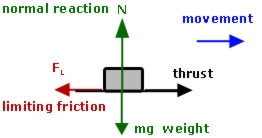
1. The limiting frictional force (FL) is directly proportional to the normal contact force (N)
![]()
note: the limiting frictional force is the maximum frictional force
2. The ratio of the limiting frictional force ( FL ) to the normal contact force( N ) is called the coefficient of friction (μ) ... the Greek letter 'mu'
![]()
3. When there is no motion, but the object is on the point of moving,
applied force = frictional force (limiting friction)
and when there is motion,
applied force > frictional force(limiting friction)
then this equality applies:
FL = μ N
Up to this point, when the frictional force is less than limiting friction(maximum)*, then the inequality below applies.
FL< μ N
*object is static and not on the point of moving
Example #1
A flat stone is thrown horizontally across a frozen lake.
If the stone decelerates at 2.5 ms-2 , what is the coefficient of friction between the stone and the ice? (take g=10 ms-2)

Example #2
A 2 kg mass in limiting equilibrium rests on a rough plane inclined at an angle of 30 deg. to the horizontal.
Show that the coefficient of friction between the mass and the plane is √3 / 3 .
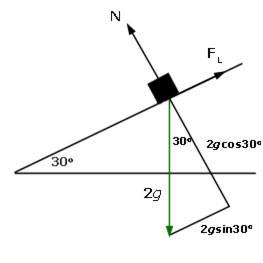
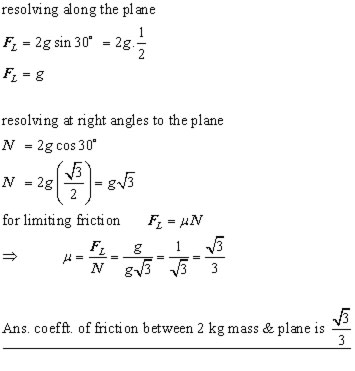
The Angle of Friction
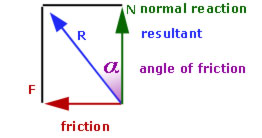
If we examine the normal reaction force( N ) and the frictional force( FL ) when it is limiting, then the equation FL = μ N applies.
If the resultant between N and FL is R , and it is inclined at an angle α(alpha) to the normal N, then we can write equations for FL and N in terms of R .
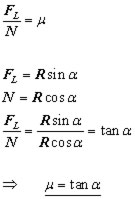
In Example #2(above) the angle of friction = tan -1(√3 / 3)
= tan -1(0.5773) = 30o (the angle of the plane)
[ About ] [ FAQ ] [ Links ] [ Terms & Conditions ] [ Privacy ] [ Site Map ] [ Contact ]
